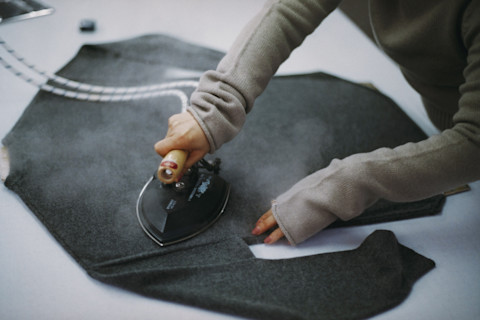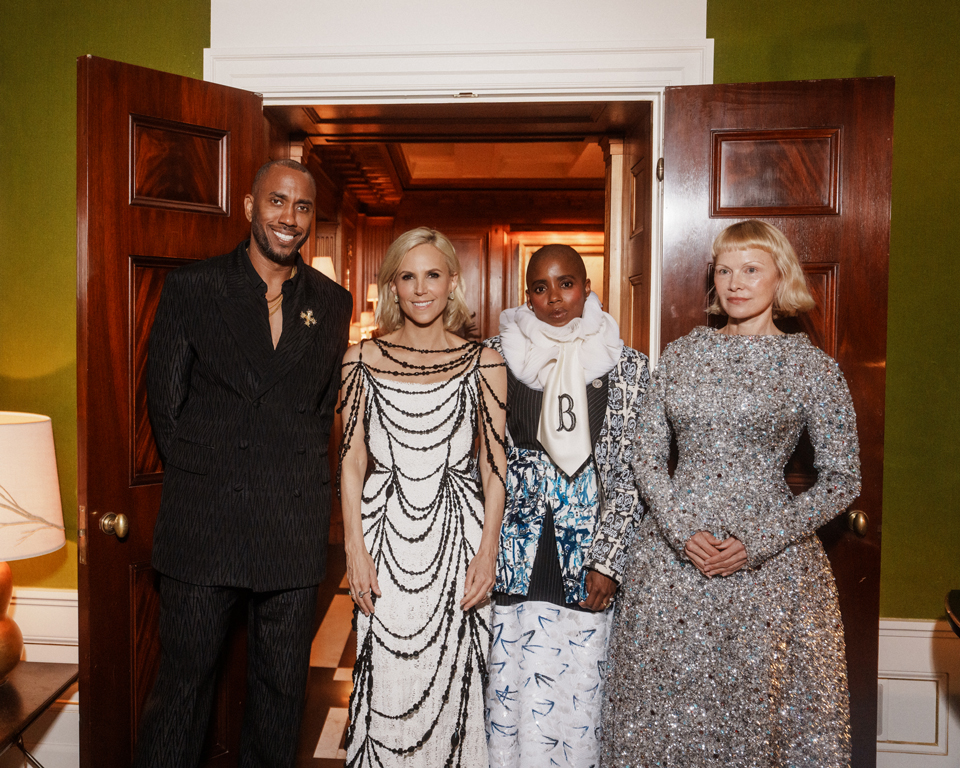Cashmere Pilled
How investing in a quality knit can deepen your appreciation for clothes.

A few years ago, all the sweaters in my closet, I realized, were nearing death. Threadbare crew necks and hoodies, some of which I knew were expensive, came to represent, in my mind, a false bill of goods. They were cool—or I thought so when I bought them—because they advertised what I was interested in (billboards for my affiliations, my favorite colors, etc.), but like so much of modern clothing, they were designed to fall apart with each wash, never meant to be taken care of or appreciated beyond their utility or the trend they belonged to. Made from cotton and polyester blends, these items were destined to expire. Not that they were ever alive—the second I bought them and donned them, they were limp and dead.
Sorting through the carcasses of these sweatshirts, looking at the frayed seams and loose threads, I started to wonder if I might be able to avoid this feeling of dread, that all the money poured into my closet over the years was a waste. Like so many things in life, the answer to my question did not come from my own toils, but from someone smarter and more elegant than me: my girlfriend.For her, clothing was not merely an index of one’s ability to keep up, but something instinctual: luxury, in her mind, is not about brands but about alchemy and geometry—of clean, simple silhouettes and well-made material that feels nice on the body, wear after wear, day after day.After a year of dating, she gifted me a vintage black cashmere V-neck sweater for our anniversary. The care label said it was made in Italy, and the year on the eBay listing dated the garment to the late ’80s. It was older than me by about a decade, and it was truly beautiful—soft and warm but breathable, a wardrobe staple that seemed to work across three seasons, maybe even four if a cold front rolled in on a summer day. It remains my favorite piece of clothing, the first piece of knitwear that made me understand the beauty of fine fabrics.Perhaps it comes with age, but I’ve noticed more and more men around me coming to this same realization. If you’re going to spend top dollar on a so-called hero item in your wardrobe, a great knit is tough to beat: the dollar value of each thread, touched and sourced by someone who cares, feels quite literal. Sneakers and outerwear once commanded the menswear enthusiast’s imagination—and in some respects still do—but I’ve seen a wider appreciation and wider availability of wonderful knits out in the world.Walking down the streets of my neighborhood, I can spy guys whose love of fine fabrics is quite clear: AURALEE, The Elder Statesman, Taiga Takahashi, and extreme cashmere. These are just a few of a growing number of contemporary brands that uphold, and maniacally focus, on the craftsmanship of knitwear; clothing makers who understand what is lost in so much fashion today—giving us something that will last.


I spent a considerable portion of my tax return a year ago on a “perfect” navy blue sweater, made with lambswool from Donegal, Ireland, which is renowned for its textiles. Unlike the sweatshirts I had tossed in the garbage, this piece of clothing was truly alive: like the hair on my head, lambswool requires care and attention to maintain its health and robustness. But what I can glean, even without expertise, is the time that went into making this garment. Or at least I wanted to believe that I could justify the sheer cost of the purchase by talking to experts: I wanted to know if it was possible to rationalize, in scientific or economic terms, the emotional value of this splurge.“Knits represent a perfect distillation of quality and handiwork and value,” Erin Schwartz, a reporter at ’s The Strategist told me, when I asked them to explain this inchoate feeling this new sweater gave me. They added: “Knits are post-trend and that’s also why they are cool. They are timeless. Unlike pants, knits can be around forever because they can be styled in different ways.” But just as important: “There is something emotional that someone knit that you can relate to. Spinning something big and fluffy into tiny fibers is incredible.” Schwartz then turned my attention to what different fibers looked like under a microscope, to fully comprehend what was being brought to bear in a sweater. Coarse wool, fine wool, alpaca, cashmere, silk, linen, and cotton bear the mark of living things—ridges and creases and crags that look more like skin than whisps of inorganic material. (Fittingly, polyester, when seen on the microscopic level, is completely smooth.)In the flesh or under the piercing eye of an electron microscope, the threads that form one’s sweaters should be admired for their complexity, and the craftsmen who knit these things together should be properly thanked for the intensive process that makes something as simple and elemental as a sweater.On my journey to learn more about knitwear, I called up Derek Guy, a journalist and fashion historian, and he presented the drama of shopping in our age as a global tragedy, of an infinite number of choices available to the consumer, many of which are bad to begin with: “There’s a lot more confusion. Which drives hunger for knowledge. How do I figure out between all of these seemingly identical, you know, like, blue sweaters online, how do I know which one I’m supposed to buy? And answering that, it’s very, very difficult.” Like Schwartz, he emphasized that “people are tired of trends” and that there is a “general awareness that things are [crappier].”He was pragmatic in this evaluation; he felt that it was almost impossible to discern from just a label if a knit was going to be good, because no two items of clothing that claim to be 100% wool or cashmere are going to be made the same. These items are subject to the whims of supply chains and the demands of the market, and the hard work of heritage isn’t necessarily something we can know without making the plunge. Or as he put it more simply: Quality in regards to knitwear “ends up revealing itself over time, such that you’ll know if you have a good net two or three years after you’ve bought it, at which point, of course, you can’t return it.” You can still make an informed decision with research and identify the places in the world where a good sweater is reliably made. (Guy identified Scottish wool in particular.)It’s this intersection of the technical and the emotional that makes knitwear special, I think. Shopping for it requires know-how and discernment, but also reverence for the labor required—the process that begets the knit, which activates some deeper vein of feeling in a conscious consumer. “Men don’t know how to experience pleasure or yearn for it,” Schwartz told me. “Sweaters are a gateway.”If I’ve learned anything, it’s that truly loving clothes means respect for the thing before you. That’s not to say other items in our closet don’t generate that feeling of approbation, but a sought-after knit can mean something more than just a purchase; a sweater carries with it the affirming feeling of education and care. Because for anything to really last, as a good sweater should, it isn’t just about the dollars you spend, but the time you take to know what makes it good in the first place. At the very least, it’s not a bad idea to hide your assets in something tangible—good wool and fine fabrics.
The Nation. The New Yorker, The New York Review of Books,
 Superfine: Met Gala 2025 It was a rainy night, but nothing could dampen the joyful atmosphere of the Met gala “red carpet,” which was blue and patterned with flowers for the evening. This year’s exhibition, “Superfine: Tailoring Black Style” explores the history of Black style and particularly Black dandyism based on the work of Barnard professor Monica L. Miller who collaborated on the show with Costume Institute curator Andrew Bolton.
Superfine: Met Gala 2025 It was a rainy night, but nothing could dampen the joyful atmosphere of the Met gala “red carpet,” which was blue and patterned with flowers for the evening. This year’s exhibition, “Superfine: Tailoring Black Style” explores the history of Black style and particularly Black dandyism based on the work of Barnard professor Monica L. Miller who collaborated on the show with Costume Institute curator Andrew Bolton.  Introducing Summer 2025 A season for California dreaming. The Summer 2025 campaign was set in Los Angeles, perfectly timed for the opening of our strikingly redesigned store on Rodeo Drive. Photographer and director Oliver Hadlee Pearch shot on location at the Hearst House, an Old Hollywood residence renovated in the 1950s by actor-turned-interior designer Billy Haines. The gently dramatic mood of the interiors provided a contrast for the bright and buoyant sunshine outdoors. Stylist Brian Molloy dressed influencer and entrepreneur Devon Lee Carlson into the collection’s textured and embellished silk dresses and retro striped knits, along with our newest handbags: the sleek Kira Turnlock and slouchy-cool Romy Hobo bag.
Introducing Summer 2025 A season for California dreaming. The Summer 2025 campaign was set in Los Angeles, perfectly timed for the opening of our strikingly redesigned store on Rodeo Drive. Photographer and director Oliver Hadlee Pearch shot on location at the Hearst House, an Old Hollywood residence renovated in the 1950s by actor-turned-interior designer Billy Haines. The gently dramatic mood of the interiors provided a contrast for the bright and buoyant sunshine outdoors. Stylist Brian Molloy dressed influencer and entrepreneur Devon Lee Carlson into the collection’s textured and embellished silk dresses and retro striped knits, along with our newest handbags: the sleek Kira Turnlock and slouchy-cool Romy Hobo bag. 
